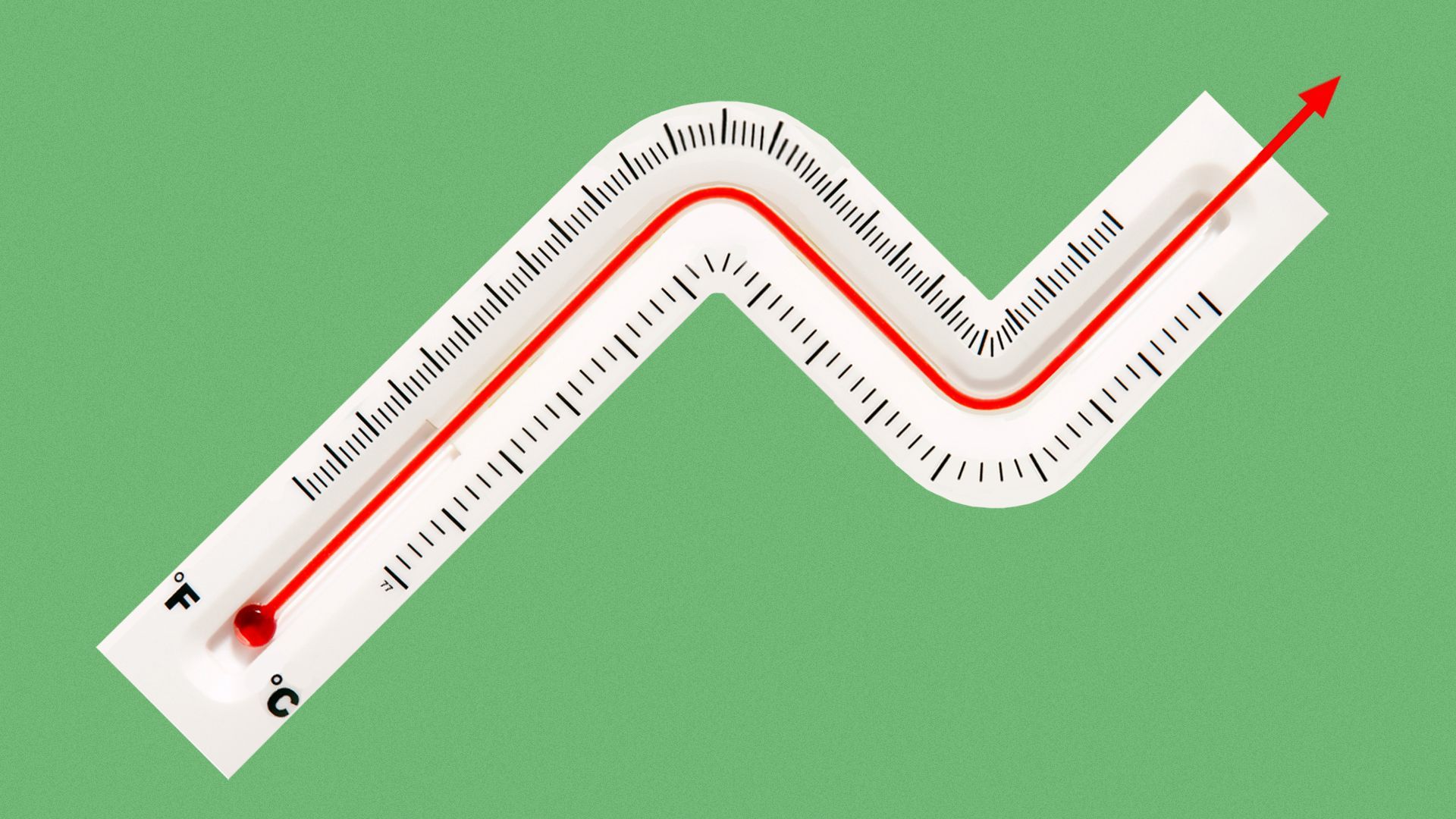| | | | | | | Presented By DiversyFund | | | | Axios Markets | | By Dion Rabouin ·Feb 22, 2021 | | Happy Monday! Was this email forwarded to you? Sign up here. (Today's Smart Brevity count: 1,325 words, 5 minutes.) 💡 Trivia: A noted draftsman, engineer, author and inventor, this man worked with Alexander Graham Bell and Thomas Edison while also developing patents of his own, including the "Process of Manufacturing Carbons," an improved method for the production of carbon filaments for lightbulbs, the electric lamp and a forerunner of the air conditioner called the "Apparatus for cooling and disinfecting." | | | | | | 1 big thing: U.S. growth expectations are going through the roof |  | | | Illustration: Annelise Capossela/Axios | | | | Expectations for U.S. growth in the first quarter, for the year and even for 2022 are roaring higher as economists race to price in the impact of big government spending, vaccinations and higher inflation. Why it matters: These bullish expectations are unusual — not only are they historically high, even given the large contraction the country suffered in 2020, but also because they seem to completely disregard any fears of the weak U.S. labor market or rising prices to get in the way. Driving the news: Bank of America chief economist Michelle Meyer was the latest to raise her GDP growth targets — to 6% for 2021 and 4.5% for 2022. - Meyer's bullish prediction is even more rosy-eyed than the latest from the exceptionally exuberant Goldman Sachs, which raised its GDP expectations to 7% for this year (including expectations for 6%, 11%, 8.5% and 6% growth for each of the year's quarters) but 2.4% GDP growth next year.
- "The risk is that growth will be even stronger given prospects for greater stimulus," Meyer wrote in a note to clients Friday.
- "The impact of the House $1.9tn Covid relief bill, if enacted, will have delayed and diminishing returns. As such, while greater stimulus will drive up growth for 2021 there could be more potential upside for 2022."
Between the lines: Meyer even argues that the U.S. output gap surplus could increase to 3.9% by the end of next year, "which would be the greatest surplus since 1973." How it works: Pantheon Macroeconomics chief economist Ian Shepherdson says the services sector will be the main beneficiary of the upcoming surge in spending, "But people have so much cash that spending on goods can keep rising too," he said in a note. - "Scope for further increases in auto sales and purchases of housing-related items is still substantial."
Where it stands: The New York Fed's GDPNow tracker estimates the U.S. will see 8.3% GDP growth in the first quarter. - The Atlanta Fed's GDPNow tracker forecasts 9.5% growth this quarter.
|     | | | | | | Bonus chart: Real-time data shows continued struggle |  Data: New York Fed; Chart: Axios Visuals The bubbly outlook for 2021 does not square with the New York Fed's reading of real-time economic data, which is once again trending lower thanks to Thursday's initial jobless claims reading and a decrease in rail traffic, which more than offset increases in retail sales and tax withholding. By the numbers: First-time unemployment reports totaled nearly 1.4 million for the week ending Feb. 13 — over 862,000 traditional claims and more than 516,000 Pandemic Unemployment Assistance claims (an increase of almost 175,000 from the previous week). - It was the 48th straight week that at least 1 million people had filed for unemployment benefits and a substantive increase from the past two weeks when the number of initial jobless claims first began rising.
- Rail traffic also showed a 7% decrease in total carloads from its commensurate 2020 level and a decline from its weekly average, according to data from the American Association of Railroads.
One level deeper: The jobs recovery has come to a screeching halt and over the past few months an increasing number of businesses are citing reasons other than the pandemic for pullbacks in hiring and rising layoffs. - And an increasing number of companies, especially small businesses, are again noting the difficulty of finding workers, despite an unemployment rate that both Fed chair Jerome Powell and Treasury Secretary Janet Yellen say is at a real rate of 10% and a labor force participation rate at its lowest level since 1975.
Further, even though top economists have largely shrugged off inflation worries, U.S. gas prices have reached their highest in a year, according to data from GasBuddy, mortgage rates jumped to a three-month high last week and food prices hit a 6.5-year high last month. - All are expected to keep rising.
|     | | | | | | 2. Catch up quick | | The FAA will require "stepped up" inspections of Boeing 777 aircraft that contain the same engine model that failed over Denver this weekend after United Airlines and Japanese regulators grounded Boeing jets with the same engines. (NBC News) Cryptocurrency exchange Coinbase was valued at just over $100 billion in a recent private market share sale and could go public at a higher initial valuation than any U.S. tech company since Facebook. (Axios) |     | | | | | | A message from DiversyFund | | Have $500 or more to invest? Check out this platform | | |  | | | | 18,000+ everyday investors have joined the DiversyFund community and have invested over 38MM on their investing platform. DiversyFundwork makes it easier to grow your net worth through its Growth REIT with no management fees, and a low minimum of $500. Sign up to get started. | | | | | | 3. Scoop: Small businesses say even second round of PPP not enough | | Many small businesses have applied for and received funds from the latest iteration of the government's Paycheck Protection Program, but most say they will need more help, a new survey from Goldman Sachs provided first to Axios shows. What's happening: Only 11% of firms that received a PPP loan say they are very confident they will be able to maintain payroll if no further government relief is provided and 67% of loan recipients expect to exhaust their second loan funding in April or May. - The survey of 1,293 Goldman Sachs 10,000 Small Businesses participants conducted Feb. 15-16 found that 66% of small businesses qualified for a second PPP loan and 83% of those who qualified have applied for a second PPP loan.
- 43% don't think their business will return to normal until either the fourth quarter or 2022.
- 55% of those who received the loans were able to hire or rehire some employees.
Heads up: The new PPP loans were part of the $900 billion relief package signed by former President Trump in January, and President Biden is expected to temporarily limit big companies from applying, Axios reports. The big picture: The latest round is shaping up to be much like its predecessor: A temporary help to some companies, but far short of a panacea for the small business sector. - Thus far, 50% of small business owners have dipped into their personal savings and 58% have foregone paying themselves.
Watch this space: Just 30% of small business owners said they were very confident they could get access to a line of credit or loan for their business from a financial institution, compared to 54% who said they were very confident they could access one pre-pandemic. - 82% of small business owners agreed it was important for Congress to create a new loan program to provide small businesses with access to longer-term capital.
Keep it 💯: Goldman analysts note that financing woes are that much worse for Black-owned businesses. - 73% of eligible Black business owners have applied for a second PPP loan, compared to 83% of all small business owners.
- 42% of Black business owners who have applied for a second PPP loan have been approved and received loan funding (vs 54% overall).
- 16% of Black business owners are very confident they would be able to access a line of credit or loan for their business from a financial institution (30% overall).
|     | | | | | | 4. The cost of money has been rising significantly |  Data: St. Louis Fed/Tradeweb; Chart: Axios Visuals U.S. real yields are rising, meaning the cost of borrowing money is again turning positive — at least for longer maturities. Why it matters: Borrowing money has essentially been free for quite some time, benefiting big companies (and governments) by allowing them to accumulate huge sums of debt that have little real cost. - Negative real yields — the value of U.S. Treasury yields minus inflation — have been a major justification for extreme price-to-earnings ratios for U.S. stock exchanges, particularly the Nasdaq.
State of play: The yield on 30-year Treasury Inflation-Protected Securities, aka real yields, turned positive on Friday for the first time since June 2020, according to Tradeweb data, punctuating a sizzling pickup that has been brewing over the last week. - 30-year real yields have risen 27 basis points from their Feb. 10 close and are up 40 basis points so far this year.
- 10-year yields remain negative but have risen by 25 basis points since Feb. 10.
Be smart: "This means the economy is on the mend; so it's not unhealthy that real yields are rising," Mark Holman, CEO of TwentyFour Asset Management, told Bloomberg. - "But I caution that if real yields rise too quickly, then that's a problem for all asset classes. It's the speed of the change that could be a worry."
The big picture: Increasing inflation expectations have sent nominal Treasury yields to their highest levels in nearly a year for 10- and 30-year maturities, with breakeven rates — which measure inflation expectations over time — rising to multiyear highs as well. - The difference between yields on the 5-year and 30-year Treasury bonds rose to the highest since 2014.
What to watch: A main reason for the increasing yields has been the Fed's insistence that it won't put the brakes on its easy-money policy and will allow for prices to run above its 2% target for "some time." - New York Fed President John Williams said on Friday that he is not worried that too much government spending could overheat the U.S. economy.
|     | | | | | | A message from DiversyFund | | Invest without the worry of Wall Street manipulation | | |  | | | | DiversyFund is democratizing wealth, with their high value, private, non-traded REIT, one investor at a time. Diversify your portfolio with alternative investments, like multifamily real estate, to avoid the rollercoaster of the market. Become an investor today with as little as $500. | | | | Thanks for reading! Trivia: A noted draftsman, engineer, author and inventor, this man worked with Alexander Graham Bell and Thomas Edison while also developing patents of his own, including the "Process of Manufacturing Carbons," an improved method for the production of carbon filaments for lightbulbs, the electric lamp and a forerunner of the air conditioner called the "Apparatus for cooling and disinfecting." Answer: Lewis Latimer, who wrote the first-ever book about the electrical lighting industry in 1890. | | | | Axios thanks our partners for supporting our newsletters.
Sponsorship has no influence on editorial content. Axios, 3100 Clarendon Blvd, Suite 1300, Arlington VA 22201 | | | You received this email because you signed up for newsletters from Axios.
Change your preferences or unsubscribe here. | | | Was this email forwarded to you?
Sign up now to get Axios in your inbox. | | | | Follow Axios on social media:    | | | | | |






No comments:
Post a Comment